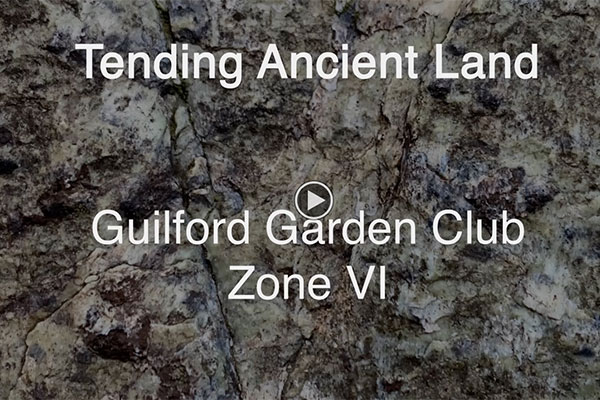
Restoration

The area encompassing the Baltimore City park now known as Lake Roland was part of an 18th century land grant from Lord Baltimore to several Maryland families. The centerpiece of the park is a reservoir, known as Lake Roland, that was formed in the 1850’s as a water source for Baltimore’s growing population. In the 1940’s the land surrounding the lake was consolidated by Baltimore City to form Robert E. Lee Memorial Park. Today, the park encompasses 503 acres of walking trails surrounded by wetlands, meadows, rocky plateaus, and mature hardwood forests and is home to two National Register Historic Districts. Guilford Garden Club (GGC) has been one of many partners working to maximize the potential of the park.
Historic District
The Lake Roland Historic District comprises about half of the 500 acres around the dam. It was listed in 1992 by Maryland and the Federal Government thanks to the work of the Robert E. Lee Park Conservancy, an organization founded in 1983 with very generous financial and membership support from the Guilford Garden Club.
Caretaker’s Cottage Native Plant Garden
In 2001, GGC members undertook to clean up and restore the area around the Caretaker’s Cottage. “Project Clean Stream” united volunteers to removed trash and invasive plants from this area of the park. GGC members designed a garden for the space and filled it with native trees and plants. The Conservancy disbanded in 2009 when oversight of Lake Roland passed from Baltimore City to Baltimore County. State and County funds became available to make significant improvements to revitalize the park, which was renamed Lake Roland. Under the stewardship of the Lake Roland Nature Council (LRNC), the park added a trestle bridge, pavilion, Acorn Hill play area, Paw Point Dog Park, and the Lake Roland Nature Center. The Lake Roland Nature Center is a green focused building open year-round, with 2,594 square feet of classroom, meeting, and educational space. In 2014, discussions began among members of LRNC’s Executive Board, Master Plan Committee, and Environmental and Historic Preservation Committee, and Guilford Garden Club (GGC) about the need for a master plan for Lake Roland.Nature Center Landscape Concept Plan
In 2015, members of GGC and LRNC engaged ecological landscape designer Larry Weaner and his associates Rebecca Kagan, L.D., Jenna Webster, L.D., and Andropogon emeritus principal Carol Franklin, L.A. to develop a master plan to conceptualize, fully design, and eventually install a single project that would serve as a prototype that could be applied in other areas of the park. The site selected for this multi-phase pilot project was 5 acres of Sycamore- dominant forested wetland stretching westward behind the park’s new Nature Center. GGC and LRNC also contracted with the consultants for a Short-Term Invasive Management Plan so that volunteers could begin to remove invasive plants to prepare for the next phases of the pilot. Century Engineering, a local engineering firm, generously donated surveyor time to provide drone photography of the site and layout of the trail network. LRNC and GGC volunteers installed sequential trail stakes. In 2020, Phase I of the Nature Center Pilot project, the Concept Plan, was completed. This Concept Plan was funded using proceeds from several Native Plant Sales orchestrated by an army of volunteers from both GGC and LRNC held at Lake Roland.Bare Hills Barrens Adaptive Management Plan
Concurrently, LRNC and GGC undertook a second project in a different part of the park – the restoration of a portion of the park known as Bare Hills Serpentine Barrens. At Bare Hills, only 3 to 4 acres of remnant serpentine savanna remain of a once much larger grassland, which was kept “barren” for millennia through disturbance: grazing of giant, prehistoric herbivores, fire by Native Americans, and mining in the late 19th and early 20th centuries. The remnants are in scattered patches, the largest not much more than 1 acre in size, within roughly 80 acres of Virginia pine – eastern red-cedar forest. Less than 80 years ago the largest contiguous area of serpentine grassland at Bare Hills covered about 125 acres. This disappearing serpentine grassland is one of the most globally rare natural communities. Roger Latham, Ph. D. research ecologist, conservation biologist, environmental planner and principal of the firm Continental Conservation was engaged to lead this restoration project. The goal is to develop an adaptive management plan which could avert further losses by ecological restoration and ecological maintenance – expanding the grassland and putting in place effective substitutes for the historical disturbance regime and other dynamic ecosystem processes for long-term sustainability. GGC participated in funding the Adaptive Management Plan through plant sales as well as two grants secured through affiliation with the Garden Club of America and its Partners for Plants (P4P) initiative. This grant money has funded the on-going development of the adaptive management plan in Bare Hills.Plant, Preserve, and Protect Natural Resources.
- P.O. Box 196, Riderwood, Maryland 21136
- GuilfordGC@gmail.com
Copyright © 2025 Guilford Garden Club • All rights reserved. • Developed by Kohn Creative


